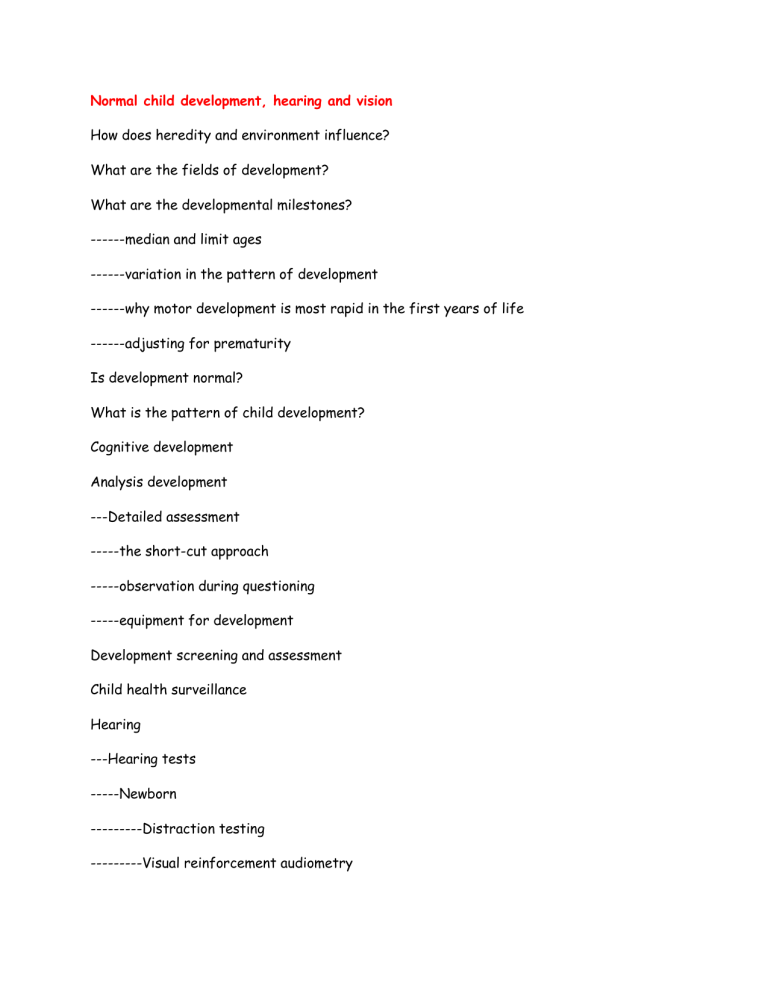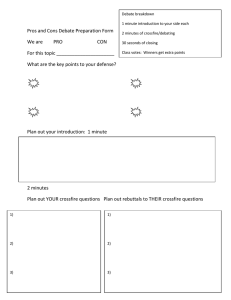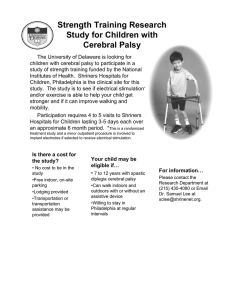
Normal child development, hearing and vision How does heredity and environment influence? What are the fields of development? What are the developmental milestones? ------median and limit ages ------variation in the pattern of development ------why motor development is most rapid in the first years of life ------adjusting for prematurity Is development normal? What is the pattern of child development? Cognitive development Analysis development ---Detailed assessment -----the short-cut approach -----observation during questioning -----equipment for development Development screening and assessment Child health surveillance Hearing ---Hearing tests -----Newborn ---------Distraction testing ---------Visual reinforcement audiometry ---------Performance and speech discrimination testing ---------Audiometry -----Parental concern Vision ----Vision testing Developmental problems and the child with special needs Abnormal development Development delay Abnormal motor development i.Cerebral palsy i.causes ii.clinical presentation spastic cerebral palsy dyskinetic cerebral palsy Ataxic(hypotenic) cerebral palsy Disordered speech and language development Abnormal development of social/communication skills(autism spectrum disorders) Slow acquisition or cognitive skills/ general learning difficulty Specific learning difficulty --Developmental coordination disorder or dyspraxia --Dyslexia --Dyscalculia, dysgraphia --Disorder of executive functions --Associative comorbidities of specific learning disorder --Management of specific learning disorders --Problems with concentration and attention -----Attention deficit hyperactivity disorder Hearing impairment --Sensorineural hearing loss --Conductive hearing loss Abnormalities of vision and the ocular system --Nystagmus --Squint(strabismus) ----corneal light reflex test ----cover test --Refractive errors -----Hypermetropia(long sight) -----Myopia(short sight) -----Astigmatism(abnormal corneal curvature) -----Amblyopia --Severe visual impairment Multidisciplinary child development services Education Transition of care to adult services The rights of disabled children Care of the sick child and young person Primary care Secondary care --Emergency and urgent care --Hospital admission rates Children in hospital --Putting the family and child at the centre of care --child-orientated environment --Information and psychosocial support --skilled staff --Multidisciplinary care – coordinating care across boundaries --Tertiary care and networks --Discharge from hospital Pain in children --Acute pain --Chronic pain --Management -----Recognizing pain -----Responding to pain -----Reassessing pain Prescribing medicines for children --Absorption --Biology --Clearance --Distribution Communication serious problems --Initial interview Palliative and end-of-life care --Care plan --Place of care --Care after death --Caring for staff Ethics --Definitions of the principles of medical ethics --Application of ethical principles to paediatrics -----Non-malefience -----Beneficence -----Justice -----Autonomy -----Truth telling --Consent --Confidentiality --Best interests --The ethics of research in paediatrics Evidence-based paediatrics --Why practice evidence-based paediatrics? --To what extent is paediatric practice based on sound evidence? Paediatric emergencies The seriously ill child Cardiopulmonary resuscitation The seriously injured child Respiratory failure Shock Sepsis Anaphylaxis Neurological emergencies Apparent life-threatening events Unexpected death of a child --sudden infant death syndrome Accidents and poisoning Accidents --Accident prevention --Head and neck injuries --Internal injuries --choking, suffocation and strangulation --drowning --Burns and scalds Poisoning --Investigation and management --Chronic environmental poisoning -----paracetamol -----button batteries -----carbon monoxide -----salicylates -----tricyclic antidepressants -----ethylene glycol -----alcohol -----Iron -----hydrocarbon(paraffin, kerosene) -----organophosphorus pesticides Child protection Types of child abuse and neglect --Physical abuse --Emotional abuse --sexual abuse --Neglect --Fabricated or induced illness --Intimate partner violence --Female genital mutilation Prevalence of child maltreatment Safeguarding children --Risk factors --Presentation -----Child abuse and neglect -----------fracture -----------Bruises -----------Burns -----------Bites --Neglect --Emotional abuse --Sexual abuse --Investigation --Management Genetics Chromosomal abnormalities Disorders of chromosome numbers --Down syndrome(trisomy 21) ----Clinical features ----Cytogenetics --------Meiotic nondisjunction --------Translocation --------Mosaicism --Edward syndrome(trisomy 18) --Patau syndrome(trisomy 13) --Turner syndrome(45, X) --Klinefelter syndrome(47, XXY) Structural chromosome anomalies --Reciprocal translocation --deletions --duplications ---testing for submicroscopic copy number variants Mendelian inheritance --Autosomal dominant inheritance -----variation in expression -----non-penetrance -----De novo mutation ------Homozygosity ------Knudson two-hit hypothesis --Autosomal recessive inheritance -----consanguinity --X-linked inheritance --Y-linked inheritance Unusual genetic mechanism --Trinucleotide repeat expansion mutations --Mitochondrial or cytoplasmic inheritance --imprinting and uniparental disomy Polygenic, multifactorial or complex inheritance Dysmorphology --pathogenic mechanism -----Malformation -----Deformation -----disruption -----dysplasia --Clinical classification of birth defects -----single-system defects ----sequence ----association ----syndrome --Syndrome diagnosis Gene-based therapies Genetic services --Genetic investigations ----Cytogenetic analysis-karyotype ----FISH ----Microarray comparative genomic hybridization ----PCR ----Next generation sequencing ----Linkage disequilibrium and genome-wide association studies --------Mutation analysis -------Next-generation sequencing --Genetic counseling ----presymptomatic(predictive) testing Perinatal medicine Pre-pregnancy care Antenatal diagnosis o


